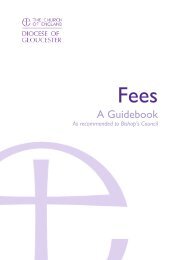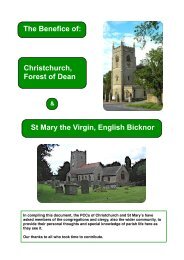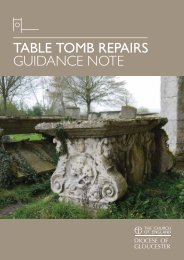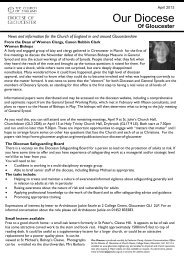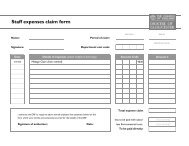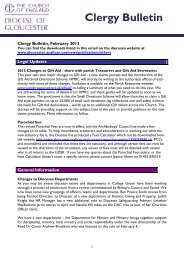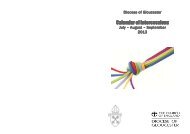Download the Revised RE Syllabus 2011 - Diocese of Gloucester
Download the Revised RE Syllabus 2011 - Diocese of Gloucester
Download the Revised RE Syllabus 2011 - Diocese of Gloucester
You also want an ePaper? Increase the reach of your titles
YUMPU automatically turns print PDFs into web optimized ePapers that Google loves.
Religious Education in <strong>Gloucester</strong>shire - Agreed <strong>Syllabus</strong> <strong>2011</strong>-2016<br />
The following case studies give a picture <strong>of</strong> <strong>the</strong><br />
diverse ways in which <strong>RE</strong> can be delivered in<br />
primary schools:<br />
School A: <strong>RE</strong> as lead subject<br />
<strong>RE</strong> is an essential part <strong>of</strong> <strong>the</strong> creative teaching strategy<br />
at School A. They plan <strong>RE</strong> as <strong>the</strong> lead subject for some<br />
<strong>of</strong> <strong>the</strong>ir cross-curriculum units and twice a year hold two<br />
whole-school <strong>RE</strong> days, on a rolling two year programme.<br />
<strong>RE</strong> is <strong>the</strong> lead subject in units on KS1 <strong>the</strong>mes <strong>of</strong> Believing<br />
and Belonging. As a school with children <strong>of</strong> many different<br />
faiths it is important to show religion as part <strong>of</strong> life.<br />
One whole-school <strong>RE</strong> day aimed to make a study <strong>of</strong><br />
inspirational people whose beliefs have made a difference.<br />
Following a whole-school assembly in which teachers<br />
spoke about people who had inspired and influenced<br />
<strong>the</strong>m, children looked at <strong>the</strong> lives <strong>of</strong> people from a variety<br />
<strong>of</strong> faiths whose beliefs had led <strong>the</strong>m to make a difference.<br />
The day concluded with a reflection on what children<br />
might do, inspired by <strong>the</strong>ir person study, e.g. make a<br />
collection for a children’s hospice after looking at <strong>the</strong> work<br />
<strong>of</strong> Sister Frances Dominica.<br />
School B: Linking <strong>RE</strong> and art<br />
Following an <strong>RE</strong> unit <strong>of</strong> work on ‘Who was Jesus and<br />
why do people follow him’ KS2 pupils unpacked <strong>the</strong>ir<br />
understanding and questions through <strong>the</strong> arts. Working<br />
in pairs or individually, <strong>the</strong>y chose an artistic medium<br />
through which to express <strong>the</strong> complexity <strong>of</strong> <strong>the</strong>ir thoughts.<br />
These media included clay, 3-D models, 2-D collage,<br />
paint, dance, drama and music.<br />
One child created a cube with a ‘light’ inside symbolising<br />
Jesus and each ‘face’ represented a different way people<br />
have <strong>of</strong> perceiving this religious leader. Some faces had<br />
windows into <strong>the</strong> light and some didn’t. A collapsed papiermache<br />
model <strong>of</strong> <strong>the</strong> world with a cross above it represented<br />
a child’s understanding <strong>of</strong> salvation and resurrection.<br />
Ano<strong>the</strong>r model <strong>of</strong> barbed wire and light images was entitled<br />
‘The Pain and <strong>the</strong> Glory’.<br />
The school has seized o<strong>the</strong>r <strong>RE</strong> and Art opportunities as<br />
a pr<strong>of</strong>ound way <strong>of</strong> capturing children’s understanding and<br />
ideas. They are excellent assessment opportunities as<br />
<strong>the</strong>y bring toge<strong>the</strong>r <strong>the</strong> child’s learning about and learning<br />
from a particular <strong>the</strong>me.<br />
School C: Exploring World War II<br />
As part <strong>of</strong> a cross curricular unit on <strong>the</strong> Second World War,<br />
Yr 6 children explored <strong>the</strong> questions <strong>of</strong> ‘What does it mean<br />
to be Jewish’ and ‘Do religious beliefs help people<br />
survive in times <strong>of</strong> suffering’<br />
The teacher describes <strong>the</strong> thinking behind <strong>the</strong> unit: ‘This<br />
year I decided that <strong>RE</strong> should move into <strong>the</strong> centre ground<br />
taking a rightful place alongside history and literacy in <strong>the</strong><br />
<strong>the</strong>me exploring <strong>the</strong> Second World War, with all three<br />
subjects contributing skills and knowledge. The <strong>RE</strong> focus<br />
is on Judaism; <strong>the</strong> key concept is identity.<br />
‘Alongside learning about Jewish beliefs and community<br />
as part <strong>of</strong> our <strong>the</strong>me, our Y6 also reflected on <strong>the</strong>ir own<br />
identity and <strong>the</strong>ir own place in society.’<br />
In History pupils say that <strong>the</strong>y:<br />
• discovered how and why <strong>the</strong> war began. We learnt about<br />
evacuation and how children experienced going away<br />
from home. We leant about <strong>the</strong> Blitz, what happened<br />
and how people tried to keep safe from <strong>the</strong> bombing raids.<br />
In <strong>RE</strong> pupils say that <strong>the</strong>y:<br />
• read what a Jewish boy called Samuel believed was<br />
important in his life today, what his special times were<br />
and what he might change about his life. We thought<br />
about and made comparisons with our own lives too;<br />
• did some role-play about <strong>the</strong> events in <strong>the</strong> Exodus to<br />
show how God would care for <strong>the</strong>m in times <strong>of</strong> trouble;<br />
• had small group and class discussions about Jews and<br />
<strong>the</strong>ir experiences <strong>of</strong> <strong>the</strong> Holocaust. We talked about <strong>the</strong><br />
ways <strong>the</strong>y tried to continue <strong>the</strong>ir traditions such as trying<br />
to use margarine rations to light <strong>the</strong> menorah in <strong>the</strong> labour<br />
camp. This was Rabbi Hugo Gryn’s story;<br />
• imagined what it must be like to be persecuted, and<br />
thought how strong <strong>the</strong> Jews must have been to cope<br />
with <strong>the</strong> torture.<br />
In Literacy, pupils say that <strong>the</strong>y:<br />
• read poetry from <strong>the</strong> young people who were held in <strong>the</strong><br />
Terezin ghetto;<br />
• noticed <strong>the</strong>y used metaphors and imagery with powerful<br />
vocabulary to create a picture <strong>of</strong> <strong>the</strong>ir feelings. We tried<br />
to think about how abstract nouns, such as happiness,<br />
despair, hope and fear, might look as a metaphor, and<br />
used poetry techniques such as similes, kennings and<br />
alliteration to produce our own poems on <strong>the</strong> <strong>the</strong>me <strong>of</strong><br />
‘Hope’.<br />
13






